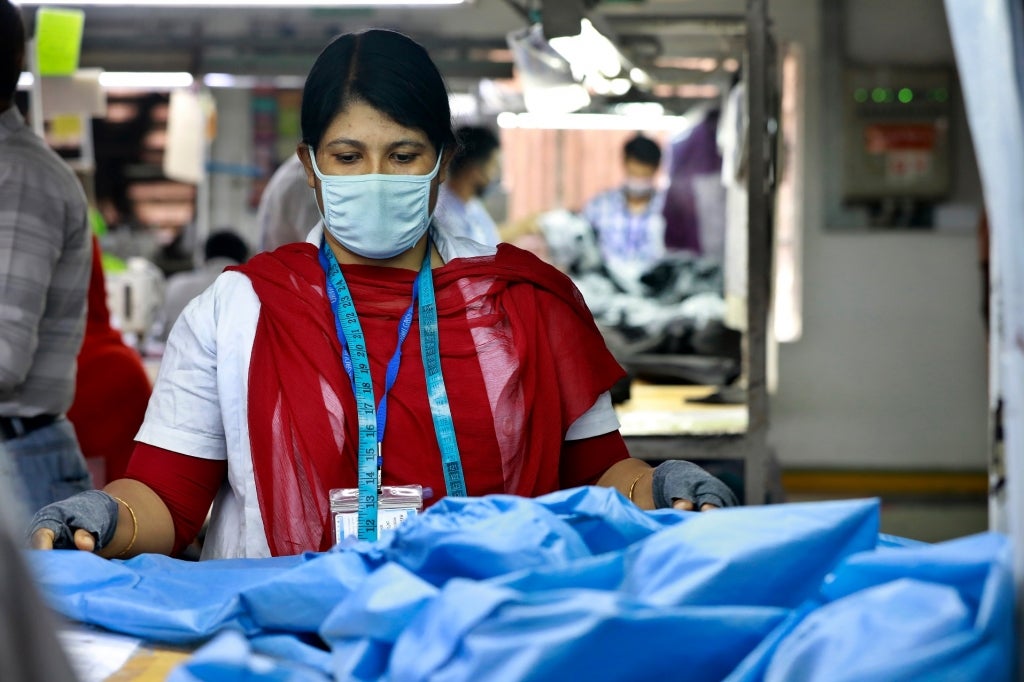 Girl from a village in the mountains of Nepal is attending school and laughing in the classroom.
Girl from a village in the mountains of Nepal is attending school and laughing in the classroom.
Samina rose from humble beginnings in Karachi, Pakistan to become a proud woman business owner employing nine people. Her embroidery business helped pay for her kids’ school and made her the primary earner in her household. Then COVID hit, trampling on her sales and dreams. She now struggles to make ends meet.
South Asia has been hit particularly hard. Almost two-thirds of the new global extreme poor—those who became poor or could not escape poverty due to COVID-19—now live in South Asia.
The pandemic has also exposed the extreme vulnerability of informal workers, comprising 80% of the workforce of some South Asian countries.
Routine health service delivery has been severely disrupted. In India, TB case notifications were down 84% and in Afghanistan, government health facilities have performed 23% fewer surgeries. The pandemic has also exposed the extreme vulnerability of informal workers, comprising 80% of the workforce of some South Asian countries.
South Asia could take years to recover from the pandemic as families cope with regaining and maintaining the momentum to ensure learning for their children, deal with unemployment, and face food insecurities —widening the gap in inequality, a key driver of poor human capital.
How do we best combat these grim statistics and build back better?
The Path Forward
The priority for countries going forward should be to pave the way for a green, inclusive, and resilient recovery. Part of building back from COVID-19, especially for South Asia, is to prepare for future shocks. This calls for re-envisioning the delivery of essential services such as health, education, and social protection.
The World Bank is working with South Asian countries to respond to the COVID-19 pandemic and build a long-term trajectory for human capital development beyond the pandemic.
We are helping countries work on pandemic preparedness and emergency response capacity. For example, the Sri Lanka COVID-19 Emergency Response and Health Systems Preparedness Project is helping the government respond to urgent health needs and provide emergency income support to the poor and vulnerable, while helping strengthen the country’s health systems for pandemic preparedness. In Bhutan, the Emergency Response and Health Systems Preparedness Project strengthened preparedness, supported contact tracing and early warning systems, and funded the procurement of medical and testing supplies.
Inclusive access to primary and secondary education will help ensure today’s children can be tomorrow’s productive adults.
A key priority is ensuring that students, especially girls, can learn during the pandemic and return to schools when they reopen. Inclusive access to primary and secondary education will help ensure today’s children can be tomorrow’s productive adults.
The EQRA project in Afghanistan is reaching girls in grades 1-9 for the first time via an alternate, community-based education system in areas where there were no physical schools before. In Bangladesh, long-term efforts with the Harmonized Stipend Program aim to improve access and retention in secondary education for girls, given the emerging evidence that girls are likely to be spending more time on household chores and childcare than education with COVID-19 restrictions in place.
In Nepal, investments in education for children and adolescents—especially girls—are taking center stage with the Unlocking Human Capital for a Prosperous Nepal Project. In Pakistan, the COVID-19 Response, Recovery, and Resilience in Education Project is supporting the nation’s recovery from the pandemic while establishing the technical and institutional capacity to build back a stronger and more resilient education system.

Informal workers have paid a very heavy price during the COVID-19 crisis, as they have no access to significant savings or benefits such as paid sick leave or social insurance. In India—where informal workers comprise 90 percent of its workforce—we are helping the nation fill important gaps in its social protection system and adapt to the needs of informal workers. This includes expanding the social protection programs from being mostly focused on rural areas to cover the whole country and ensuring portability of benefits for migrant workers.
In Maldives, we are helping create jobs. The COVID-19 Emergency Income Support Project is helping Maldivian women like Zahida, 30, who have either been laid off or whose income has been impacted by the COVID-19 crisis. “[The Income Support Allowance] helped me to pay my rent,” said Zahida. “Without the allowance, I [would] have to return back to my island.”
Amidst monumental challenges, the COVID-19 pandemic has given the world an opportunity to build back better. To do this, we must recognize that people are the wealth of nations—the bedrock of human capital. Continued support and a special focus on human capital in IDA20 will be critical to contain the impacts of the pandemic and raise the level of ambition for human capital acceleration in the region.
South Asia is well on its way to turning adversity into opportunity and together, we can lay the foundation for a green, inclusive, and resilient recovery for all—a world where everyone can truly reach their full potential.


Join the Conversation